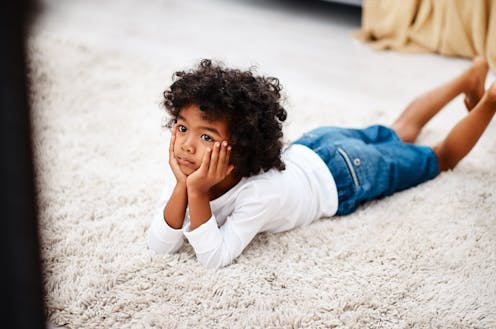[ad_1]

It’s a familiar feeling for many parents. No matter what you suggest, your pre-schooler just wants to watch that episode of Bluey again, never mind that it’s just finished playing. And at bedtime, it has to be a book you’ve read frequently enough to have developed a repertoire of specific voices for every character.
These deep and repetitive interests in a TV episode, game or topic may be frustrating to parents who just want to watch something different. But this repetition actually has great benefits for children’s learning and wellbeing.
One reason for this is what we can call the “input effect”. This isn’t a new concept in cognitive science.
Searching for patterns
Think of the brain as an organ doing its best to figure out what is normal in our lives – what’s part of a regular pattern and what isn’t. Researchers have discovered a phenomenon known as “statistical learning”. According to this idea, children are very sensitive to the occurrence of regularities and patterns in their lives.
Interestingly, babies are particularly adept at understanding certain types of material, such as the likelihood of certain sounds in the speech we address to them. But they need to be exposed to many examples of this in order to detect regularities.
For instance, in all languages, and English is no exception, the sounds included in words tends to follow certain patterns. In English, for instance, some of the most common combinations of three letters are “the”, “and” or “ing”. It makes sense that children’s brains search for repetition – in this example, it will help them learn language.
So, when young children return to watch the same show, what they are doing, whether they know it or not, is driven by a desire to detect and consolidate the patterns in what they are watching, hearing or reading.
Familiar comfort
As well as supporting learning, repetition also has benefits for children’s emotions, in what we are calling here the “wellbeing effect”.
The main job of childhood is learning, and that means actively seeking out new experiences and stimuli. However, having to process and adapt to new things can be exhausting – even for a toddler with boundless energy.
The world can also be a stranger and more stressful place for children than it is for adults. As an adult, you will have learnt what to expect and how to behave within particular contexts, but children are constantly encountering new situations for the first time.

Smolina Marianna/Shutterstock
Well-known stimuli, such as that TV episode they’ve already watched umpteen times, can provide a source of comfort and security that buffers against this stress and uncertainty.
Deep interests in a particular activity can also provide wellbeing benefits through a sense of control and mastery. Children are constantly being challenged and stretched in what they know and understand at nursery, school and elsewhere. This is crucial for learning, but it also presents a threat to their feelings of competence.
Being able to relax into an activity that they feel good at, such as a favoured game, fulfils these competence needs. In addition, being able to opt into an activity that they enjoy lets them have a sense of autonomy and control over their lives, which is otherwise often spent being whisked here and there by parents.
Of course, not all children are equally likely to develop these kinds of repetitive interests. For example, autistic children often show particularly focused interests.
There is huge value to be gained from repetition in terms of learning and wellbeing. So, while you shouldn’t be forcing them to rewatch shows, you also don’t need to be concerned if this is something they’re pursuing themselves. However, it can become problematic if it affects the child’s ability to engage with other important aspects of their life, such as getting out of the house on time, interacting with others, or doing physical exercise.
Of course, there is no rule of thumb that can be applied to all children in all contexts. As parents, we can only be attentive to the situation and make a decision. But as you queue up Frozen yet again, think about the input and wellbeing effects, and perhaps give yourself a break from worrying that your child should be doing something – anything! – else.
![]()
The authors do not work for, consult, own shares in or receive funding from any company or organisation that would benefit from this article, and have disclosed no relevant affiliations beyond their academic appointment.
[ad_2]
Source link



